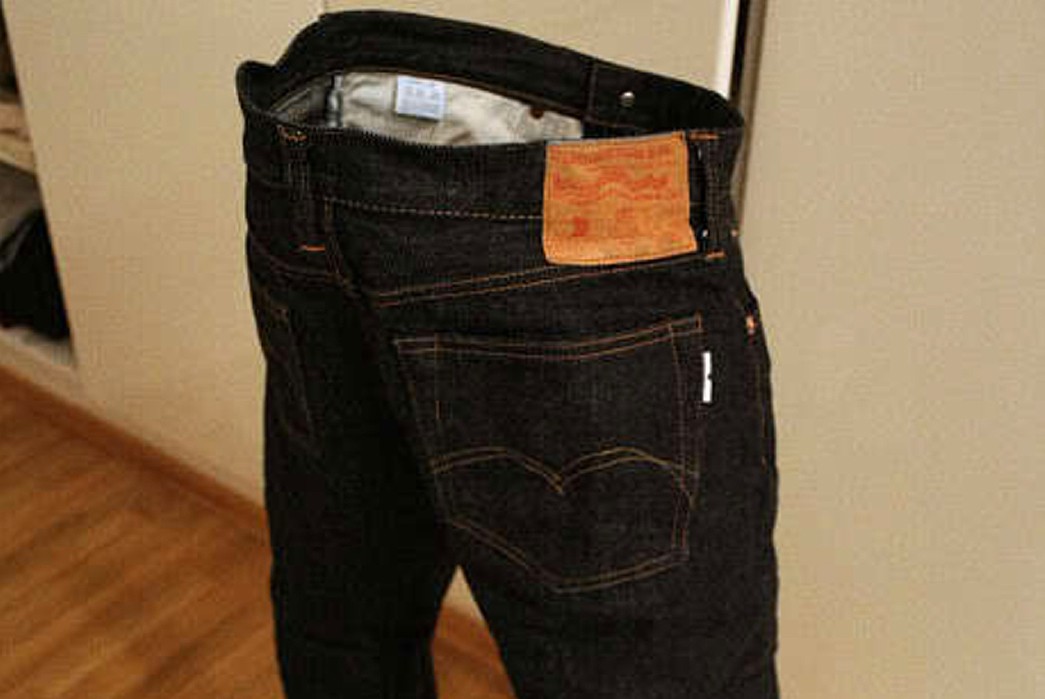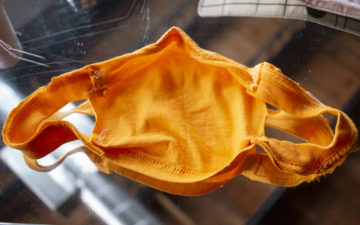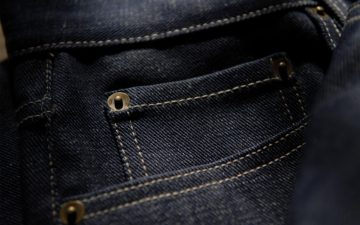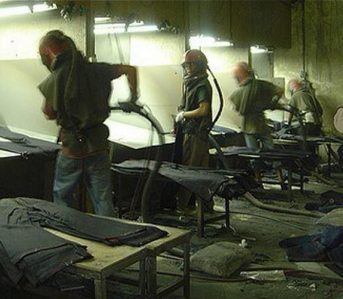Any newcomer to raw denim researching and reading about the topic is likely to have come across the issue of whether or not they should “starch” their raw denim. Yours truly included. I had no clue what “starching” meant (“You mean the stuff you eat?”), what the reason for it was, and whether it was worth all the trouble.
After much surfing across forums, blogs, and articles, I finally learned more about the process and how it all came to be. One of the biggest reasons for wearing raw denim is the fading/creasing achieved, which is partially due to how raw (i.e. stiff) the denim initially is. Since applying starch stiffens any textile fabric, the thinking is then that starching raw denim = more profound creases = stronger fading. Whilst this can be great if you want intense fading and fast, there’s a bit more to the equation you should be aware of.
Why do People Starch Denim?
- Fadez – Starching denim makes it stiffer, meaning it is more abrasive and the creases it develops are deeper and more intense. This leads to quicker dye loss, higher contrast fading, and an overall more prominent fade pattern.
- Dirt protection – When denim is starched, dirt and sweat particles tend to stick to the starch instead of the clothing fibers. This makes stains easier to remove. For this reason, people working in dirty, dusty environments have been known to starch their denim. Notably cowboys and ranch hands.
- Sheen – Starch can leave your jeans with a slight sheen which can improve the luster of denim. Some people like this look, giving them another reason to starch their jeans.
- Adding hold – Some folks want their jeans to stack and have an overall stiff appearance, which starch helps to achieve by making the denim more rigid.
What is Starch and How Does It Work?
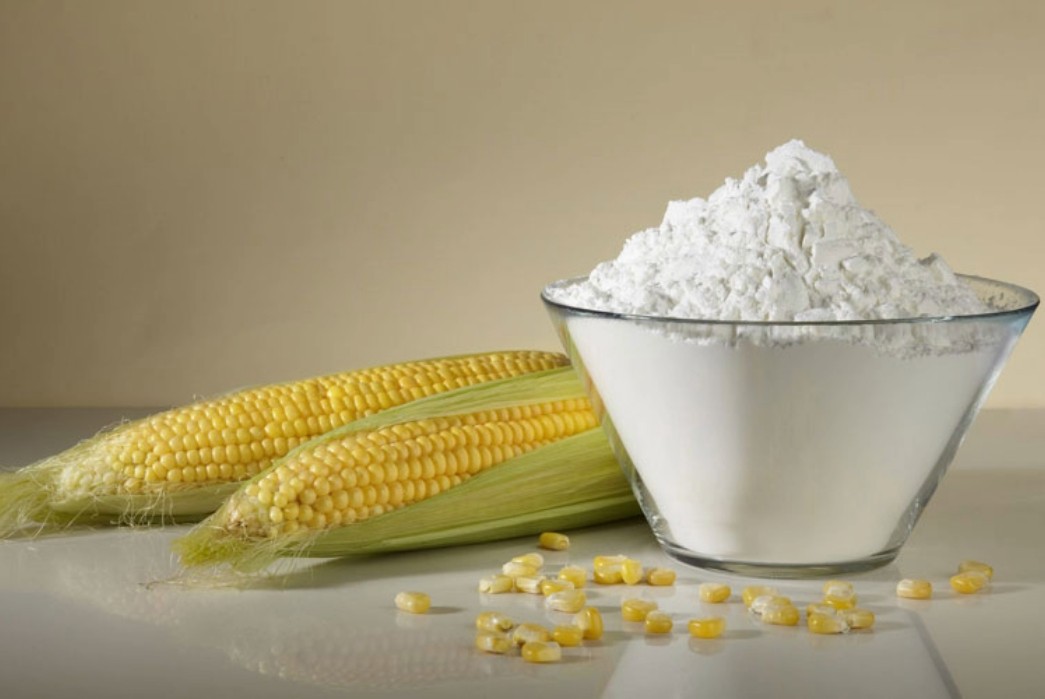
Starch via PrestiVac.
Starch is a natural substance from corn, wheat, or potatoes. When applied to clothes and heated, it causes stiffness by temporarily filling in gaps between the fibers and fusing them together.
Is Starching Necessary?
So, is starching really necessary? Does it expedite the fading process and make a difference? Well, different strokes for different folks. You’re bound to come across some who think starching is “so 2006” and makes your jeans stink, but others will advocate you just need to “do it right” and will swear by it every time (true starch slingers – see below).
To be honest, I have yet to starch anything I’ve ever owned (the result of being a little bit lazy) but am interested in giving it a shot and seeing the result.
Potential Issues
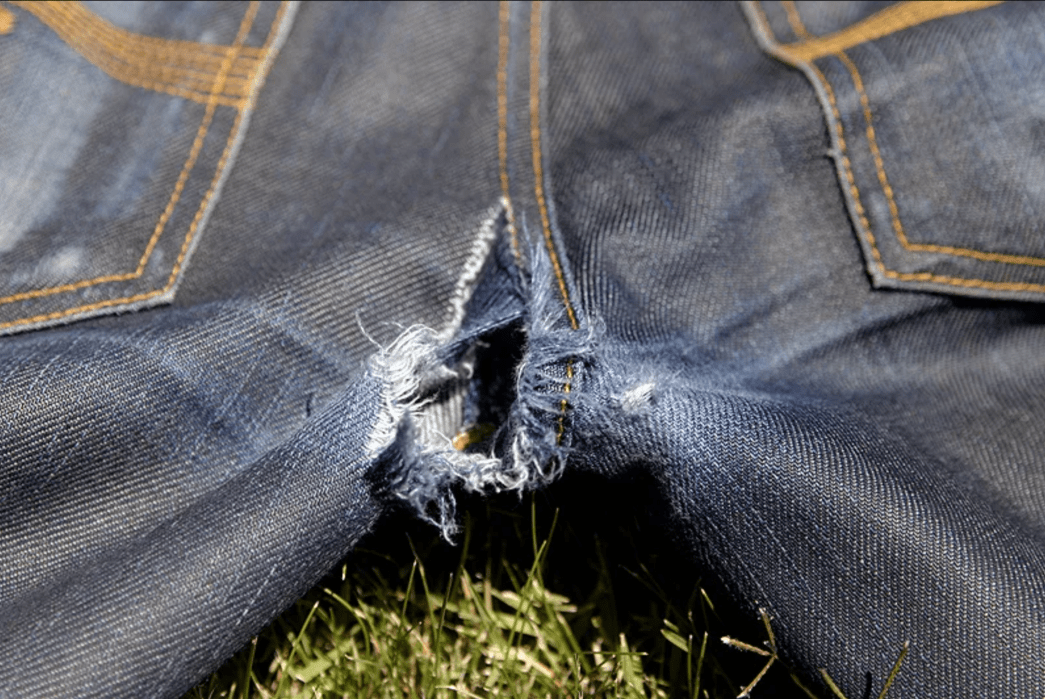
Crotch blowout via DannyUK/Imgur.
The potential issues with starching raw denim jeans are underpinned by the fabric being stiff and crunchy. While some people are into this, it is uncomfortable. In addition, the fabric being dryer and stiffer means it is more abrasive. Again, this leads to comfort issues, but it can also give rise to blowouts and fraying. If you want your jeans to crock and fray, this is great, but repairing blowouts is always annoying.
How To Starch Raw Denim
If you do feel compelled to starch your denim, here are 3 ways to do it. After you’ve chosen sure to choose an option before using our shopping list!
Shopping list:
- Starch – Spray, raw, or liquid solution depending on your chosen method
- Spray bottle (optional)
- Iron
- Sponge (optional)
- Tub or bucket (optional)
- Clip Hangers
Method 1 – Spray ‘n’ Iron
- Apply – If spraying, apply from 8-10 inches distance on an ironing board or flat surface, and work in 12-inch sections and until damp. If using liquid formula, work liquid into the denim liberally but be careful not to drench. It isn’t a bad idea to use a sponge.
- Iron – Now a lot of people out there will throw up red flags when hearing “iron” and “raw denim” in the same sentence, but I say take a look at the washing instructions on the inner tag and go from there. If it strictly shows an iron icon with a big X through it, then do not. Otherwise, you should be good to go. Just iron your jeans through a towel or on low heat to reduce the risk of burning the starch or indigo dye.
- Continue – Continue Steps (1) – (3) until finished
- Hang – Hang jeans on a hanger or washing line, ensuring the dying environment is mild to warm and most importantly, dry.
Method 2 – Soak
- Wash your jeans to remove any stains or dirt. You don’t want the starch to lock in bacteria. Let them dry using your normal method. (see here for our guide to washing raw denim jeans)
- Fill a tub or bucket with cold to lukewarm water, enough to submerge your jeans in.
- Make a cornstarch slurry from 1.5 tbsp of cornstarch to 2 cups of water, or reach for a ready-made solution. Pour the slurry or solution into the water and mix well.
- Submerge your jeans into your container of water/starch solution and agitate them to ensure there are no air bubbles.
- Leave jeans to soak for no more than 15 minutes.
- Remove your jeans from the water, lay them on a couple of towels to catch the excess water, and hang dry.
Method 3 – Machine Assisted
- Purchase some starch solution. You can make your own mix but washing machines are expensive and important, so go for something specialized.
- Put your jeans into a washing machine with some detergent and select the cycle you feel is most appropriate – a handwash or a delicate cycle is advisable.
- Pause your machine just before it enters the rinse cycle.
- Add starch solution to the detergent compartment of your washing machine and unpause the cycle. The Jeans will now be rinsed with the solution.
- When the cycle ends, remove your jeans from the dry and hang dry them until they are about 85-90% dry, i.e. leaving them slightly damp.
- Iron – Now a lot of people out there will throw up red flags when hearing “iron” and “raw denim” in the same sentence, but I say take a look at the washing instructions on the inner tag and go from there. If it strictly shows an iron icon with a big X through it, then do not. Otherwise, you should be good to go. Just iron your jeans through a towel or on low heat to reduce the risk of burning the starch or indigo dye.
If you know of a better starching method or a way to enrich the stiffness factor, please feel free to share it in the comments below.
